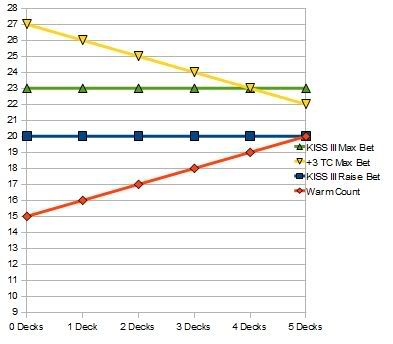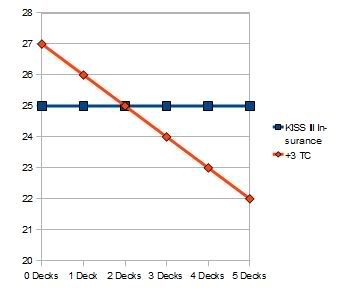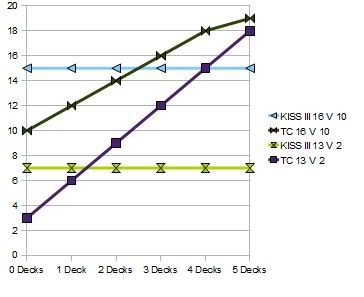Here's a little something I've been playing with since I've read Color Of Blackjack and I know a lot of people don't like to use unbalanced counts because of the fact that it's not always entirely accurate. With what I'm doing here I believe you can be more accurate than a balanced count, as long as you can keep an accurate running count, and can estimate within a 1 deck range.
All of the things listed here should be done after you have already mastered the KISS III count as ways to improve your game. So take from here what you like and what you're comfortable with.
I came up with the TC in all of these methods by using the formula
RC-(IRC+2*Decks Dealt) then divided by Remaining Decks = True Count if anyone needs to create different points.
The first thing I'd like to add will turn a lot of people off to the idea of improving their game because the entire point of using an unbalanced count is simplicity. Well after a bit of time the simplicity becomes second nature and it doesn't take much to add some more pieces to our game. We all know that KISS III is a great count for betting purposes, but we all also know that when we upgrade from KISS II to III we are actually giving up a lot of our playing efficiency and our insurance correlation. But we really don't have to!
The only difference between II and III is that III counts the Aces and 7's, where as II does not. So if we keep a side count (I said it!) of Aces vs 7's we can add that to our RC for betting purposes and just use the black 2's, 3's, 4', 5's, 6's, and 10's for our main count.
This really sounds harder than it is. Since KISS users don't have to convert it's basically just keeping two RC's and doing simple addition or subtraction before making the bet. The easiest method I've found is to count 7's as A, B, C so on and so forth and for Aces to be Z, Y, X, W. So if you saw cards come out 3, 7, 5, 9, 10, 7, Ace your count would go (IRC 9) 10, 10A, 11A, 11A, 10A, 10B, 10A. Our RC would be 11 for betting purpose (10+A=11) and only 10 for playing and insurance decision. Practice on your own a bit and you'll be amazed at how fast you pick it up.
So theoretically, if you played this way with the side count, you'd have a BC of .98 (if you count all 2's as .5) or .97 if you count only black 2's, a PE of .62, and an IC of .87. That's as strong as a level 2 count, just adding to the arsenal you already have mastered!
Disclaimer: the above numbers are assuming you're true counting the KISS II and III tag values, don't worry we'll solve that problem too.

You'll also note that earlier in the shoe we're laying out our max bet before we should be (assuming you're max betting at a +3 TC). This can easily be solved by remembering a couple numbers.
At the beginning of a 6 deck shoe max bet should be placed at RC 27 or higher and lowered by 1 with each deck remaining (you'll see why these numbers are extra important in a moment!)
Conversely you have a slight advantage off the top of a shoe at RC 15 and this number should rise by 1 for every deck played. Now early on when all those low cards come out in the first hand you'll be able to notice opportunities a lot sooner!
In the chart above we can see that KISS III normally wants us to raise our bet at a RC of 20. Unfortunately that misses a lot of opportunities early on in the shoe (keep in mind "warm line" is a +1 True Count, a very slight advantage in most games, I'll post the +1.5 numbers here too.)
If your game is sub par I would recommend waiting for a +1.5 TC before raising your bets and those numbers rise by half RC's so this works better if you count all 2's as .5. They start at 18, 18.5, 19, 19.5, 20, 20.5. (Round the numbers up if you count only black 2's.) - Edit: I should note that you'd want to use this group if you only play H17 games.
The next thing I'd like to put on here is a better way to make your insurance calls. Insurance is normally taken at the RC of 25 when using KISS III. However, that's just an all around compromise. You would normally want to take it at a +3 TC which varies as decks are played as you can see here.

From here you can see that at any point, other than two decks in, we'll be slightly off from making the correct insurance call. The solution to this is very simple. Off the top of a 6 deck shoe insurance should be taken at 27 or above, and then reduced by 1 for every deck played. This is exactly the same as remembering the ramp for your max bet (told you that ramp would be important!)
This is the last thing I believe should be added to your game as this is probably the hardest one of them all, and probably the least important in a 6 deck game, but if you want to get most of the effect of that .62 PE it needs to be done. This is touched on in Fred Renzey's book Blackjack Bluebook II, but I think it gets overlooked more than it should.

As you can see here it's exactly the same as our betting and insurance ramp. The running count moves with the number of decks. But the great thing is that it's always moving in the same direction by the same amount in proportion to number of remaining decks!
Here is a few of the one's that are listed in Fred's book (don't worry, I asked permission) and you can see that they group together to make it easier (although this is probably the least important of the listed improvements.)
16 V 10 and 12 V 4 - 10,12,14,16,18,19
12 V 6, 13 V 2, and 9 V 3 - 3, 6, 9, 12, 15, 18
12 V 5, 13 V 3, 10 V 9 - -3, 1, 5, 9, 13, 17
Anyone that can, please check the math, I'm sure there are some mistakes in here somewhere as I've been drawing this stuff up over the past couple nights.
Also a lot of this is similar to the True Fudging method also described in Blackjack Bluebook II, but I've never seen anyone just lay the numbers out there for others to use.
All of the things listed here should be done after you have already mastered the KISS III count as ways to improve your game. So take from here what you like and what you're comfortable with.
I came up with the TC in all of these methods by using the formula
RC-(IRC+2*Decks Dealt) then divided by Remaining Decks = True Count if anyone needs to create different points.
The Side Count
The first thing I'd like to add will turn a lot of people off to the idea of improving their game because the entire point of using an unbalanced count is simplicity. Well after a bit of time the simplicity becomes second nature and it doesn't take much to add some more pieces to our game. We all know that KISS III is a great count for betting purposes, but we all also know that when we upgrade from KISS II to III we are actually giving up a lot of our playing efficiency and our insurance correlation. But we really don't have to!
The only difference between II and III is that III counts the Aces and 7's, where as II does not. So if we keep a side count (I said it!) of Aces vs 7's we can add that to our RC for betting purposes and just use the black 2's, 3's, 4', 5's, 6's, and 10's for our main count.
Black 2, 3, 4, 5, 6 = +1
10 = -1
7 = A, B, C, D . . .
A = Z, Y, X, W . . .
Remember the side count is a ratio, not two separate side counts!
7 = A, B, C, D . . .
A = Z, Y, X, W . . .
Remember the side count is a ratio, not two separate side counts!
This really sounds harder than it is. Since KISS users don't have to convert it's basically just keeping two RC's and doing simple addition or subtraction before making the bet. The easiest method I've found is to count 7's as A, B, C so on and so forth and for Aces to be Z, Y, X, W. So if you saw cards come out 3, 7, 5, 9, 10, 7, Ace your count would go (IRC 9) 10, 10A, 11A, 11A, 10A, 10B, 10A. Our RC would be 11 for betting purpose (10+A=11) and only 10 for playing and insurance decision. Practice on your own a bit and you'll be amazed at how fast you pick it up.
So theoretically, if you played this way with the side count, you'd have a BC of .98 (if you count all 2's as .5) or .97 if you count only black 2's, a PE of .62, and an IC of .87. That's as strong as a level 2 count, just adding to the arsenal you already have mastered!
Disclaimer: the above numbers are assuming you're true counting the KISS II and III tag values, don't worry we'll solve that problem too.
Estimating our Advantage
The next issue that people become concerned with is the fact that KISS III a lot of times will overestimate your advantage early in the shoe and underestimate it towards the end of a shoe. Luckily Daniel Dravot in Color of Blackjack has shown us an easy way to solve that problem using a warm and cold line ramp.
You'll also note that earlier in the shoe we're laying out our max bet before we should be (assuming you're max betting at a +3 TC). This can easily be solved by remembering a couple numbers.
At the beginning of a 6 deck shoe max bet should be placed at RC 27 or higher and lowered by 1 with each deck remaining (you'll see why these numbers are extra important in a moment!)
Conversely you have a slight advantage off the top of a shoe at RC 15 and this number should rise by 1 for every deck played. Now early on when all those low cards come out in the first hand you'll be able to notice opportunities a lot sooner!
In the chart above we can see that KISS III normally wants us to raise our bet at a RC of 20. Unfortunately that misses a lot of opportunities early on in the shoe (keep in mind "warm line" is a +1 True Count, a very slight advantage in most games, I'll post the +1.5 numbers here too.)
If your game is sub par I would recommend waiting for a +1.5 TC before raising your bets and those numbers rise by half RC's so this works better if you count all 2's as .5. They start at 18, 18.5, 19, 19.5, 20, 20.5. (Round the numbers up if you count only black 2's.) - Edit: I should note that you'd want to use this group if you only play H17 games.
The Insurance Decision
The next thing I'd like to put on here is a better way to make your insurance calls. Insurance is normally taken at the RC of 25 when using KISS III. However, that's just an all around compromise. You would normally want to take it at a +3 TC which varies as decks are played as you can see here.

From here you can see that at any point, other than two decks in, we'll be slightly off from making the correct insurance call. The solution to this is very simple. Off the top of a 6 deck shoe insurance should be taken at 27 or above, and then reduced by 1 for every deck played. This is exactly the same as remembering the ramp for your max bet (told you that ramp would be important!)
Index Ramps
This is the last thing I believe should be added to your game as this is probably the hardest one of them all, and probably the least important in a 6 deck game, but if you want to get most of the effect of that .62 PE it needs to be done. This is touched on in Fred Renzey's book Blackjack Bluebook II, but I think it gets overlooked more than it should.

As you can see here it's exactly the same as our betting and insurance ramp. The running count moves with the number of decks. But the great thing is that it's always moving in the same direction by the same amount in proportion to number of remaining decks!
Here is a few of the one's that are listed in Fred's book (don't worry, I asked permission) and you can see that they group together to make it easier (although this is probably the least important of the listed improvements.)
16 V 10 and 12 V 4 - 10,12,14,16,18,19
12 V 6, 13 V 2, and 9 V 3 - 3, 6, 9, 12, 15, 18
12 V 5, 13 V 3, 10 V 9 - -3, 1, 5, 9, 13, 17
Last Words
Some people may find this daunting (or even unnecessary) but I've found in my time discovering these things as I play the game that as long as you take it one at a time these are very easy to implement. A switch to a level 2 balanced may be easier for some, but as long as you make your charts and follow them perfectly you can play with far less estimation than you were before, on par or better than a true counted equivalent. Anyone that can, please check the math, I'm sure there are some mistakes in here somewhere as I've been drawing this stuff up over the past couple nights.
Also a lot of this is similar to the True Fudging method also described in Blackjack Bluebook II, but I've never seen anyone just lay the numbers out there for others to use.
Last edited:
